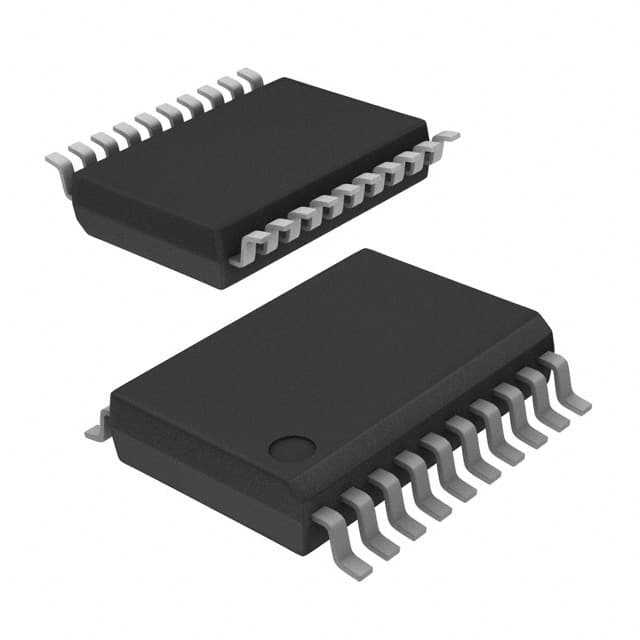Zie specificaties voor productdetails.

Encyclopedia Entry: 74F373MSA
Product Overview
Category
The 74F373MSA belongs to the category of integrated circuits (ICs), specifically flip-flops.
Use
This product is commonly used in digital electronics for storing and transferring binary data. It serves as a latch or register, allowing for the temporary storage of information.
Characteristics
- The 74F373MSA is a high-speed, octal transparent latch with three-state outputs.
- It operates on a wide voltage range, typically between 4.5V and 5.5V.
- This IC offers low power consumption and high noise immunity.
- It is designed to be compatible with various logic families, making it versatile in different applications.
Package
The 74F373MSA is available in a small outline integrated circuit (SOIC) package. This package type provides compactness and ease of integration into electronic systems.
Essence
The essence of the 74F373MSA lies in its ability to store and transfer data efficiently, enabling reliable digital signal processing.
Packaging/Quantity
Typically, the 74F373MSA is sold in reels containing multiple units. The exact quantity may vary depending on the supplier.
Specifications
- Supply Voltage Range: 4.5V to 5.5V
- High-Level Input Voltage: 2V (minimum)
- Low-Level Input Voltage: 0.8V (maximum)
- High-Level Output Voltage: 2.7V (minimum)
- Low-Level Output Voltage: 0.5V (maximum)
- Operating Temperature Range: -40°C to 85°C
- Propagation Delay Time: 6ns (maximum)
Detailed Pin Configuration
The 74F373MSA has a total of 20 pins, each serving a specific function. Here is the detailed pin configuration:
- D0: Data Input 0
- D1: Data Input 1
- D2: Data Input 2
- D3: Data Input 3
- D4: Data Input 4
- D5: Data Input 5
- D6: Data Input 6
- D7: Data Input 7
- GND: Ground
- OE: Output Enable
- Q0: Output 0
- Q1: Output 1
- Q2: Output 2
- Q3: Output 3
- Q4: Output 4
- Q5: Output 5
- Q6: Output 6
- Q7: Output 7
- VCC: Power Supply
- LE: Latch Enable
Functional Features
The key functional features of the 74F373MSA include:
- Octal transparent latch with three-state outputs.
- High-speed operation for efficient data transfer.
- Compatibility with various logic families, ensuring versatility in system design.
- Low power consumption and high noise immunity for reliable performance.
Advantages and Disadvantages
Advantages
- High-speed operation allows for quick data processing.
- Versatility in logic family compatibility enables integration into different systems.
- Low power consumption contributes to energy-efficient designs.
- Three-state outputs provide flexibility in controlling signal flow.
Disadvantages
- Limited voltage range (4.5V to 5.5V) may restrict certain applications requiring higher or lower voltages.
- Propagation delay time of 6ns may be relatively high for some high-speed applications.
Working Principles
The 74F373MSA operates based on the principles of flip-flops. It utilizes transparent latches to store and transfer data. When the latch enable (LE) signal is active, the input data is transferred to the outputs. The output enable (OE) signal controls the three-state outputs, allowing for isolation or connection to other components.
Detailed Application Field Plans
The 74F373MSA finds applications in various digital systems, including but not limited to:
- Microprocessors and microcontrollers
- Memory modules
- Data storage devices
- Communication systems
- Industrial automation
- Automotive electronics
- Consumer electronics
Its ability to store and transfer data efficiently makes it suitable for any application that requires reliable digital signal processing.
Detailed and Complete Alternative Models
There are several alternative models available in the market that offer similar functionality to the 74F373MSA. Some notable alternatives include:
- 74HC373: This IC operates at a lower voltage range (2V to 6V) and offers compatibility with CMOS logic families.
- CD74ACT373: It provides faster propagation delay times and operates at a wider temperature range (-55°C to 125°C).
- SN74LS373: This
Noem 10 veelgestelde vragen en antwoorden met betrekking tot de toepassing van 74F373MSA in technische oplossingen
Sure! Here are 10 common questions and answers related to the application of 74F373MSA in technical solutions:
Q: What is the 74F373MSA? A: The 74F373MSA is a type of octal transparent latch with 3-state outputs, commonly used in digital circuits.
Q: What is the purpose of the 74F373MSA? A: The 74F373MSA is used to store and control the flow of data in digital systems. It can latch and hold data until it is needed.
Q: How many bits can the 74F373MSA handle? A: The 74F373MSA can handle 8 bits of data, as it is an octal latch.
Q: What is the difference between a transparent latch and a flip-flop? A: A transparent latch allows data to pass through when enabled, while a flip-flop stores data and only updates its output on clock edges.
Q: How does the 74F373MSA enable or disable the flow of data? A: The 74F373MSA has an enable input (often labeled as "G") that controls whether the latch is transparent or latched.
Q: Can the 74F373MSA be used for bidirectional data transfer? A: Yes, the 74F373MSA supports bidirectional data transfer by using separate input and output pins.
Q: What is the maximum voltage the 74F373MSA can handle? A: The 74F373MSA typically operates at a voltage range of 4.5V to 5.5V.
Q: Can the 74F373MSA be cascaded to handle more than 8 bits of data? A: Yes, multiple 74F373MSA latches can be cascaded together to handle larger data widths.
Q: What is the output impedance of the 74F373MSA? A: The 74F373MSA has a low output impedance, typically around 25 ohms.
Q: Are there any precautions to consider when using the 74F373MSA? A: It is important to ensure proper power supply decoupling and avoid exceeding the maximum voltage and current ratings specified in the datasheet.
Please note that these answers are general and may vary depending on specific implementations or datasheet specifications.

